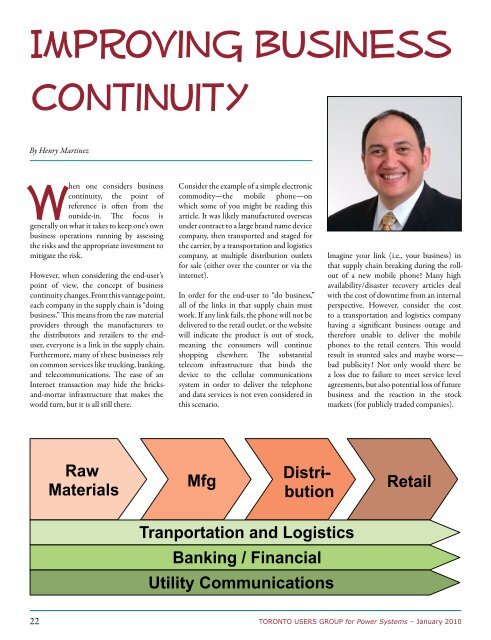Complete Magazine - PDF (5589K) - Toronto Users Group for Power ...
Complete Magazine - PDF (5589K) - Toronto Users Group for Power ...
Complete Magazine - PDF (5589K) - Toronto Users Group for Power ...
Create successful ePaper yourself
Turn your PDF publications into a flip-book with our unique Google optimized e-Paper software.
Improving Business<br />
Continuity<br />
By Henry Martinez<br />
When one considers business<br />
continuity, the point of<br />
reference is often from the<br />
outside-in. The focus is<br />
generally on what it takes to keep one’s own<br />
business operations running by assessing<br />
the risks and the appropriate investment to<br />
mitigate the risk.<br />
However, when considering the end-user’s<br />
point of view, the concept of business<br />
continuity changes. From this vantage point,<br />
each company in the supply chain is “doing<br />
business.” This means from the raw material<br />
providers through the manufacturers to<br />
the distributors and retailers to the enduser,<br />
everyone is a link in the supply chain.<br />
Furthermore, many of these businesses rely<br />
on common services like trucking, banking,<br />
and telecommunications. The ease of an<br />
Internet transaction may hide the bricksand-mortar<br />
infrastructure that makes the<br />
world turn, but it is all still there.<br />
22<br />
Raw<br />
Materials<br />
Consider the example of a simple electronic<br />
commodity—the mobile phone—on<br />
which some of you might be reading this<br />
article. It was likely manufactured overseas<br />
under contract to a large brand name device<br />
company, then transported and staged <strong>for</strong><br />
the carrier, by a transportation and logistics<br />
company, at multiple distribution outlets<br />
<strong>for</strong> sale (either over the counter or via the<br />
internet).<br />
In order <strong>for</strong> the end-user to “do business,”<br />
all of the links in that supply chain must<br />
work. If any link fails, the phone will not be<br />
delivered to the retail outlet, or the website<br />
will indicate the product is out of stock,<br />
meaning the consumers will continue<br />
shopping elsewhere. The substantial<br />
telecom infrastructure that binds the<br />
device to the cellular communications<br />
system in order to deliver the telephone<br />
and data services is not even considered in<br />
this scenario.<br />
Mfg<br />
Distri- -<br />
bution<br />
Tranportation and Logistics<br />
Banking / Financial<br />
Utility Communications<br />
Imagine your link (i.e., your business) in<br />
that supply chain breaking during the rollout<br />
of a new mobile phone! Many high<br />
availability/disaster recovery articles deal<br />
with the cost of downtime from an internal<br />
perspective. However, consider the cost<br />
to a transportation and logistics company<br />
having a significant business outage and<br />
there<strong>for</strong>e unable to deliver the mobile<br />
phones to the retail centers. This would<br />
result in stunted sales and maybe worse—<br />
bad publicity! Not only would there be<br />
a loss due to failure to meet service level<br />
agreements, but also potential loss of future<br />
business and the reaction in the stock<br />
markets (<strong>for</strong> publicly traded companies).<br />
Retail<br />
TORONTO USERS GROUP <strong>for</strong> <strong>Power</strong> Systems – January 2010





